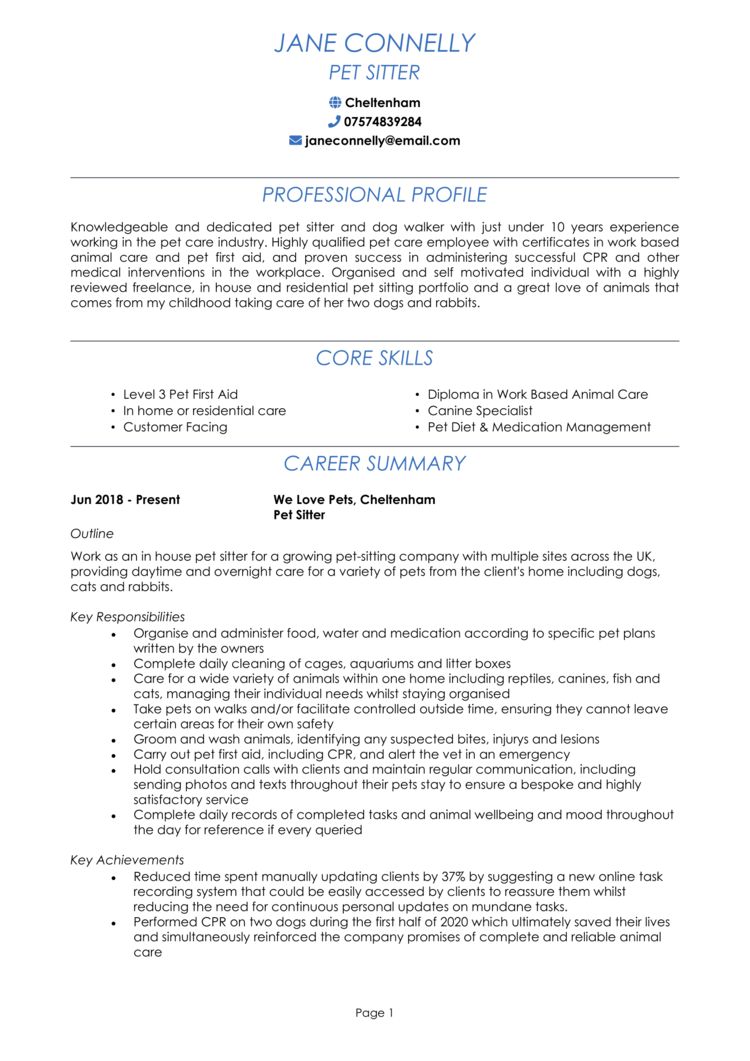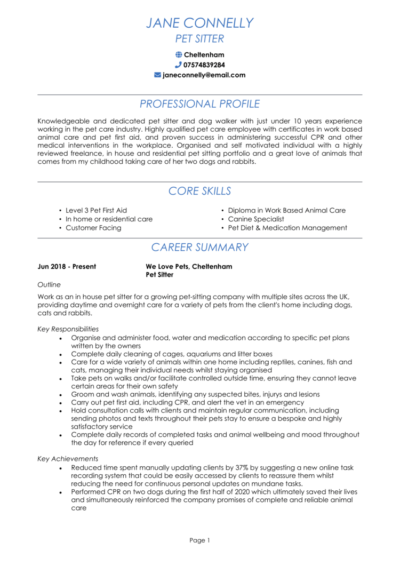Your CV should be more than a list of odd jobs – it’s your chance to prove to an employer that you’re responsible and genuinely passionate about animal care. Just like the pets you’ll be looking after, your application needs attention, and a little bit of personality to stand out.
Alongside a Pet Sitter CV example, this guide will help you shape a CV that highlights your experience and builds trust with recruiters to show exactly why you’re the safe pair of hands (and paws) they’ve been searching for.
Pet Sitter CV

How to write your Pet Sitter CV
Discover how to craft a winning Pet Sitter CV that lands interviews with this simple step-by-step guide.
Handing over a set of keys and a beloved pet is an act of trust – and your CV should inspire the same confidence. Employers want to know from the start that you’re careful, and capable of handling whatever a day with dogs or cats (or exotic pets) might throw at you.
This guide will take you through structuring, formatting, and writing a CV that makes recruiters feel as reassured as an owner coming home to a happy, healthy pet. By the end, you’ll have a document that gives you a professional edge and opens the door to new opportunities.
What’s the right way to structure and format your Pet Sitter CV?


A well-structured CV makes life easy for the recruiter. They don’t want to dig through cluttered paragraphs to figure out if you’re a trustworthy candidate – they want clear, accessible information that speaks for itself. Even the most qualified and capable candidates will miss out on opportunities if their structure is messy or full of mistakes.
Here’s the layout to follow:
- Name and contact details – Keep your name and personal details front and centre at the top. Whether or not to include a photo is your decision.
- Profile – Start with a snapshot of your skills, career highlights, and professional aspirations.
- Core skills – Focus on core skills like making it easy for employers to see your key strengths at a glance.
- Work experience – Walk through your professional experience, beginning with your latest position and moving backwards.
- Education – Outline your education and certifications, focusing on those most relevant to the role.
- Additional info – Include anything from your hobbies and interests to the languages you speak – these are all totally optional.
Presentation counts as much as content, so follow these tips to ensure the best possible CV format. Use bullet points to keep things clear, organise the CV with distinct section headings, and choose a professional font that’s straightforward to read. Keep the document concise and under two pages in length so that employers can find the essentials at a glance without losing interest.
How to create a Pet Sitter CV profile


A professional profile is your first chance to show that you don’t just enjoy being around animals – you bring measurable value to every pet sitting role you take on. In just a few lines, it should highlight your experience, your reliability, and the reassurance you offer to both pets and their owners.
Recruiters want to see at a glance that you’ll add something meaningful to their business or service, not simply that you love animals.
Pet Sitter CV profile examples
Profile 1
Experienced Pet Sitter with over 12 years of experience caring for dogs, cats, and small animals in both residential and professional settings. Skilled in managing feeding routines, administering medication, and ensuring pets receive exercise and enrichment. Proficient in using pet care scheduling apps and GPS trackers. Trusted by clients for reliability, compassion, and consistent high-quality care.
Profile 2
Reliable Pet Sitter with seven years of experience providing pet care services for busy families and professionals. Adept at walking, feeding, grooming, and maintaining safe environments for pets of all sizes. Comfortable with basic training reinforcement and emergency response procedures. Known for excellent communication with owners and attention to detail in following specific care instructions.
Profile 3
Caring Pet Sitter with three years of experience supporting households with daily visits, overnight stays, and holiday cover. Assisted with young, elderly, and special-needs pets, ensuring wellbeing and comfort at all times. Experienced in using digital booking platforms and providing photo updates for owners. Passionate about animal welfare and building strong bonds with pets.
Details to put in your Pet Sitter CV profile
Try to include the following in your CV profile:
- Where you worked – Describe the types of environments you’ve worked in, whether through agencies, private households, or animal care services.
- Your top qualifications – Mention any relevant training or certificates that show your professional commitment.
- Essential skills – Outline the practical abilities that make you suited for the role.
- Specific experience – Highlight the range of animals you’ve cared for and the responsibilities you’ve handled.
- Value provided – Point out how your reliability and professionalism benefit owners and reassure them their pets are safe.
Presenting your core skills


The CV skills section works as a fast-read summary of your abilities – almost like a quick checklist for recruiters scanning through a stack of applications. But the key is substance over filler. Instead of leaning on vague traits or generic buzzwords, this section should highlight tangible, job-specific capabilities that align closely with the requirements in the advert.
A well-chosen set of skills here shows you understand the expectations of the role and can deliver exactly what’s needed. Because it’s so quick to tailor, you can adjust this section easily for each job, helping you stay directly relevant and competitive.
Essential skills that recruiters look for in a Pet Sitter CV
- Pet Feeding and Medication Administration – Following specific dietary instructions and administering medications safely and on schedule.
- Exercise and Playtime Supervision – Engaging pets in physical activity and mental stimulation based on their breed, age, and energy level.
- Routine Monitoring and Health Observation – Watching for signs of illness, injury, or behavioural changes and notifying owners when necessary.
- Litter Box and Waste Cleanup – Maintaining cleanliness by managing litter trays, yard waste, or cage bedding as required.
- In-Home Security and Pet Safety – Ensuring pets stay safe within the home environment and following any specific safety precautions.
- Multiple Pet Care Coordination – Managing care routines for households with more than one pet, including feeding, walking, and individual attention.
- Client Instructions and Preferences Adherence – Carefully following each owner’s guidelines for pet routines, house access, and emergency contacts.
- Daily Updates and Communication – Providing regular updates, photos, and notes to reassure clients and keep them informed.
- Pet Transport and Vet Visits – Safely transporting pets when needed, including to grooming appointments or veterinary checkups.
- Basic Grooming and Hygiene Maintenance – Brushing coats, wiping paws, or cleaning ears as instructed to keep pets clean and comfortable.
How to highlight work experience


For pet sitting roles, trust and responsibility are proven through your work history. Lay out your work experience in reverse chronological order, starting with your most recent jobs.
Each role should begin with a short overview of your position and the type of work you carried out, followed by bullet points for responsibilities and achievements. Keep the detail clear and concise so recruiters can instantly see the value you’ve provided. If you’re just starting out, mention volunteer work, informal jobs for neighbours, or animal-related studies that demonstrate relevant skills.
How to make your past experience easy to read for employers

- Outline – Set the scene by describing the client, household, or agency you worked for, along with the purpose of your role.
- Responsibilities – Break down what you actually did, using action words like “supervised” or “monitored”. For example: “supervised feeding routines” or “monitored animal health and behaviour.”
- Achievements – Show the impact you had, such as improving client satisfaction or building repeat business.
Example job entries for Pet Sitters
Pet Sitter | Maplewood Pet Care Services
Outline
Provided pet sitting and home visit services for a local business catering to families and professionals. Offered care for dogs, cats, and small animals, ensuring pets were safe, healthy, and happy while owners were away.
Responsibilities
- Followed detailed feeding and exercise schedules set by pet owners
- Administered oral medication and monitored pets for signs of illness
- Provided companionship and enrichment during home visits
- Ensured homes were left secure and tidy after each appointment
- Shared daily updates and photos with pet owners via booking app
Achievements
- Maintained 100% client retention across two years of service
- Received over 60 five-star online reviews for reliability and quality care
- Helped reduce pet anxiety cases by offering extended stay services
Pet Sitter | Greenfield Pet Companions
Outline
Worked independently as part of a community-based pet sitting service, focusing on regular walks, daily drop-ins, and overnight care. Built strong relationships with repeat clients through trust and professional service.
Responsibilities
- Delivered daily exercise routines tailored to each dog’s age and breed
- Provided cat sitting services including feeding, litter changes, and play
- Monitored pet behaviour and reported any concerns to owners promptly
- Handled key holding responsibly and ensured client homes remained secure
- Offered flexible scheduling to accommodate last-minute bookings
Achievements
- Expanded client base by 40% through referrals and repeat bookings
- Maintained zero missed appointments across three years of service
- Helped two pets with dietary needs improve health through accurate feeding routines
Pet Sitter | Oakridge Animal Care
Outline
Offered pet sitting and house sitting services for a small company specialising in holiday cover. Supported pets with individualised care plans while ensuring owner peace of mind.
Responsibilities
- Provided round-the-clock care for pets during extended owner absences
- Ensured dogs received daily walks, playtime, and balanced feeding
- Maintained litter trays, cages, and enclosures in a hygienic condition
- Responded to emergencies and liaised with local vets if required
- Kept owners updated with written notes, texts, and photos
Achievements
- Achieved 95% repeat booking rate by building strong client trust
- Assisted in the recovery of a post-surgery dog through careful monitoring
- Contributed to business growth by securing five new long-term contracts
Education and qualifications


Education isn’t usually the main focus for a pet sitter CV, but it does help to show you’ve got solid foundations. List your qualifications in reverse chronological order, from most recent backwards.
If you’ve undertaken any animal care or first aid courses, make sure to include them here. If you’re new to the profession, this section can be expanded with details of relevant studies, otherwise keep it short to allow your work history to shine.
Qualifications recruiters look for in a Pet Sitter
- Level 2 or 3 Diploma in Animal Care – A recognised qualification that demonstrates knowledge of animal welfare.
- Pet First Aid Certification – Essential training that reassures employers and clients you can handle emergencies.
- City & Guilds Level 2 Certificate in Dog Walking and Pet Sitting – Directly relevant to the role and widely respected.
- RSPCA-accredited training courses – Offer practical knowledge of animal welfare and handling.
- DBS Check (Disclosure and Barring Service) – Not a qualification, but vital for demonstrating trustworthiness.





